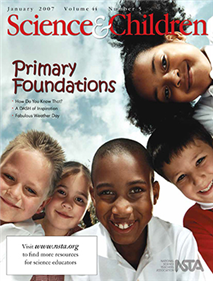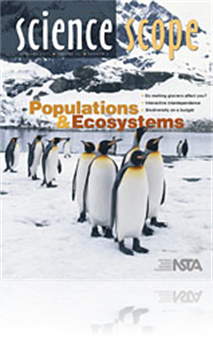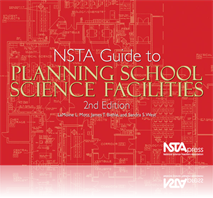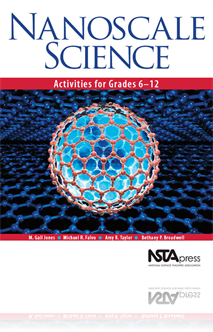All Resources
Journal Article
Methods and Strategies: Discussion Maps Make Sense!
One warm spring day, a group of 18 young children sat in a classroom discussing their ideas about plants. This was one of several discussions in a multi-age, grades 1–3 classroom in which the children were talking about living things. The plant dis...
Journal Article
Children do not have to live near the coast to experience effects of water waves. They can throw stones into a pond and see the waves ripple outward, bob up and down while floating in a swimming pool, and splash water about while in a bathtub. As stu...
Journal Article
The Effect of Seat Location on Exam Grades and Student Perceptions in an Introductory Biology Class
The effect of seat location on learning has received surprisingly little attention in education literature (Weinstein 1979). Classroom experience and education literature suggest that students who sit in the front of a lecture hall are more likely to...
Journal Article
A highly relevant topic for adolescents is the impact of drug abuse on the nervous system. Out of 49,300 U.S. secondary school students surveyed, half of them will have tried an illicit drug by the time they complete high school (Johnson et al. 2005)...
NSTA Press Book
Uncovering Student Ideas in Science, Volume 2: 25 More Formative Assessment Probes
If Hollywood filmed this sequel, the studio would call it “Probes II: More Battles Against Misunderstandings.” Like the blockbuster before it, Volume 2 will reveal the surprising misconceptions students bring to the classroom—so you can adjust ...
By Page Keeley, Francis Eberle, Joyce Tugel
Journal Article
Science Sampler: Interactive interdependence
Modifying and building on a lesson created by the Vancouver Aquarium Marine Science Centre, the British Columbia Ministry of Education, and the Provincial Learning Network (2000) that supports National Science Education Standards Teaching Standard A...
Journal Article
Books, Biodiversity, and Beyond!
Reading in science class doesn’t have to be boring, but it’s no secret to students or teachers that textbooks aren’t much fun to read. To enhance and integrate your science curriculum, try using alternative reading resources such as Biodiversi...
Journal Article
There is little doubt that well performed lecture demonstrations play an important role in science teaching (Straits and Wilke 2006): for many students, exciting demonstrations are what keep them interested and motivated. The demonstrations also help...
Journal Article
In this month’s Ask the Experts column, the following questions are addressed: I’ve heard that the two sides of my brain are specialized for different tasks (language vs. reasoning, etc.). If I listen to a science lecture on my iPod using only on...
Journal Article
Scope on the Skies: And then there were eight
This past summer the International Astronomical Union (IAU) approved new definitions for objects in our solar system that orbit the Sun. The definitions now allow for only eight planets, while objects smaller than planets will be known as dwarf plane...
Journal Article
Science Sampler: Word wall connections
A word wall has many uses in the middle school science classroom. It is ideal for reinforcing vocabulary and connections between concepts. In this article, the author describes an interactive way to use the word wall to create food webs. In addition,...
Journal Article
Coaching to Build Support for Inquiry-Based Teaching
Coaching, as a means to support inquiry-based teaching, starts by changing the culture from within (school, teacher, and student) rather than from external mandates. Recognizing that teacher empowerment is the first step toward increasing student ach...
Journal Article
From <em> Frustrating </em> Forgetfulness to <em> Fabulous </em> Forethought
Teens exhibit many types of behaviors—of both inattention and intense focus. From an adult’s perspective, one cannot help but wonder why this happens. Part of the answer lies in the neural restructuring of the adolescent brain. This article exami...
Journal Article
They’re M-e-e-elting! An Investigation of Glacial Retreat in Antarctica
Why has glacial melting occurred? What happens when that much freshwater enters the ocean? Will this melting continue? These questions inspired the authors to design a directed inquiry in which middle school students simulate glacial retreat in Antar...
Journal Article
The purpose of many animal studies at early grades is to build observation skills, develop a knowledge base, and practice age-appropriate science skills like comparing, describing, and drawing. While these are important learning experiences, the Nati...
Journal Article
Career of the Month: An interview with Clinical Neuropsychologist Deborah Attix
Neuroscience is a field dedicated to learning about the brain and nervous system, which can help us understand, prevent, and treat diseases and disorders such as Alzheimer’s, depression, and addiction. The vast scope of questions neuroscience is tr...
Journal Article
The Case Study: Intimate Debate Technique: Medicinal Use of Marijuana
This article describes the technique called intimate debate. To cooperative learning specialists, the technique is known as structured debate or constructive debate. It is a powerful method for dealing with case topics that involve controversy, such ...
Journal Article
Point of View: Questions From the Edge: Using Informal Surveys to Build Rapport With Students
“Astronomy helps us answer the ultimate question of human existence,” and “Astronomy helps us understand the meaning of our own existence.” These thoughts caught the attention of one professor who wondered what students thought about the mean...
Journal Article
Science Sampler: Using graphic organizers as formative assessment
With the move in the last decade toward a standards-based science curriculum, assessment has become an important part of science teaching and learning. National policies such as the No Child Left Behind Act place additional emphasis on the importance...
Journal Article
Editor’s Corner: Brainy Science
Despite being a subject of intense interest and scrutiny for all of human history, many aspects of human brain function are still rather poorly understood. However, this is about to change rapidly, as modern imaging techniques create a revolution in ...
Book Chapter
Advocacy and the Planning Process
Science educators believe that students construct their knowledge of the natural world best in safe, secure, and stimulating learning environments. In order to achieve these goals, teachers, researchers, and planners must become advocates for the sch...
Book Chapter
Current Trends and Future Directions in Science Education: Breaking Down the Walls
The simplest educational concept—and perhaps the most significant—to consider in designing tomorrow’s science programs is inquiry. In keeping with the Standards’ strong emphasis on inquiry-based programs, students increasingly will be explori...
Book Chapter
In order for students to inquire confidently, we must create safe classroom environments. Safety is not just a set of rules but a state of mind, and perhaps, most importantly, it is an attitude and a set of skills that carry over into a students’ d...
Book Chapter
Designing Facilities for the Middle School (6-8)
A high-quality middle school science program requires science classrooms with safe, well-designed laboratory space, and school designers must consider the distance students will have to travel to these classes. Trying to balance high quality science ...
Book Chapter
Designing Facilities for the High School (9-12)
When we participate in a school building program, we create learning environments that will last for many decades. So a major principle of good science facilities planning is to avoid building for a single curricular model. Since continued change in ...
Book Chapter
While everyone in a school community should share responsibility for the “greening” of a school, it is often the science teachers who make the best use of these facilities, basing their lessons on the components of a green school that have been b...
Book Chapter
A periodic table on the ceiling of a chemistry lab/classroom, footprints and fossils of amphibians and animals in a courtyard sidewalk, a 60-foot slinky suspended from the ceiling, and a tessellation pattern in the floor tile extend science learning ...
Book Chapter
We say it often, and the phrase appears in the National Science Education Standards and many state and local documents as well. “All students should have opportunities in science.” But that vision is harder to achieve in practice. It is especiall...
Book Chapter
Imagine metal eyeglass frames that you can roll in a ball, only to watch it uncoil back to its original shape! How can an inanimate object, such as metal, do such a thing? There is a metal alloy that can do just that and it’s one of the many discov...
Book Chapter
Socks that don’t stink, graffiti-resistant paint, windows and sunscreen that reject UV rays… that’s nanotechnology. Students will learn about some of the latest inventions using nanotechnology by exploring actual products of nanotechnology rese...








